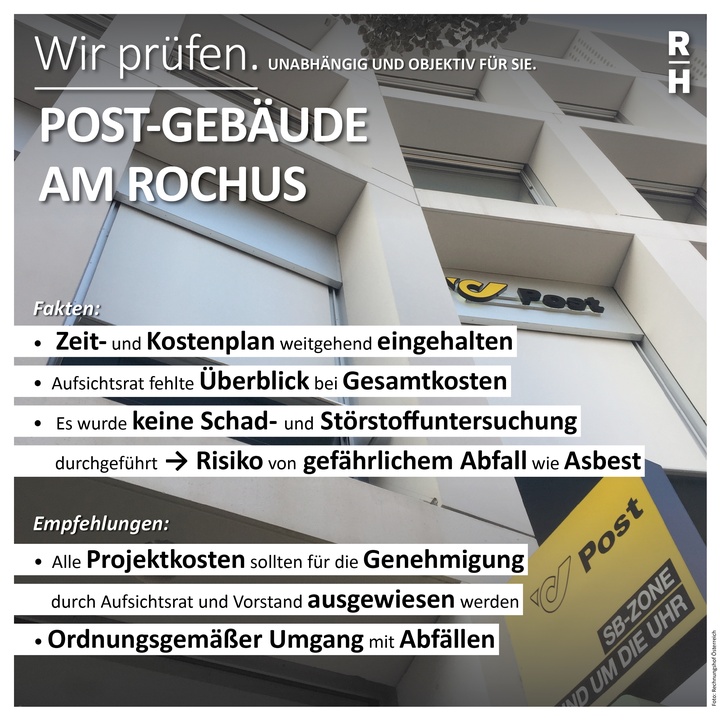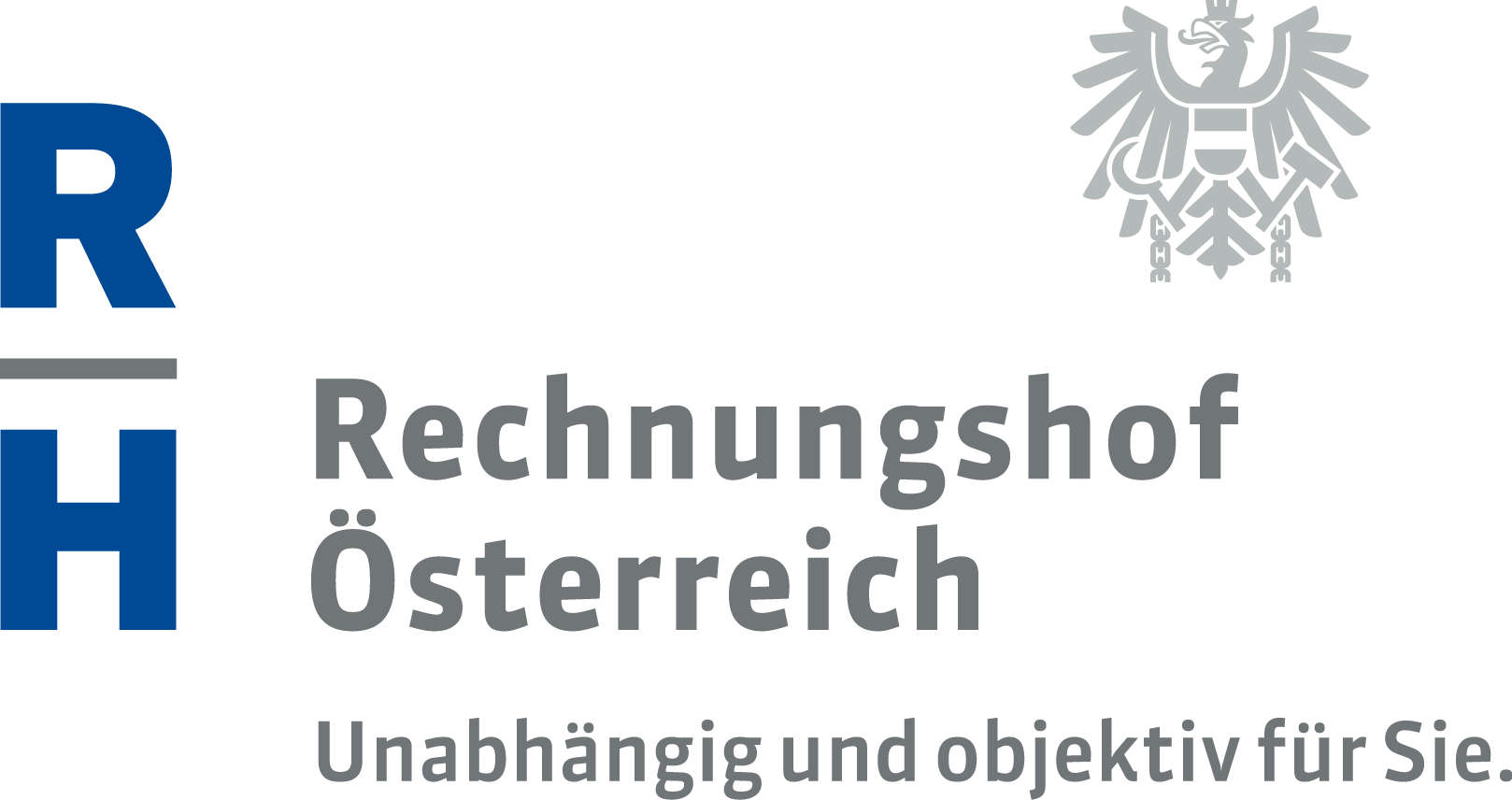The Austrian Court of Audit presents: reports on the head office of the Austrian Post, the Austrian National Library and science communication

Today, the Austrian Court of Audit (ACA) presented the following reports:
- Post Office Building at the Rochusplatz in Vienna
- Austrian National Library
- Research and Science Communication
In the period of 2014 to 2017, the Österreichische Post AG (Austrian Post) had its new head office built at the Rochusplatz in the 3rd district of Vienna for about EUR 84.21 million. The ACA audited the implementation of the construction project.
Despite the city-centre location, the listed building and the archaeological findings on the construction site, the Austrian Post implemented the project largely within the time and cost frame. However, the ACA also detected deficiencies in the implementation, namely with regard to the award of contracts, pollutant and impurity investigations and the examination of additional charges. In its report “Post Office Building at the Rochusplatz in Vienna”, the ACA furthermore points to the fact that the supervisory board had no overall overview of all the costs attributable to the project. The audit focused on the period from 2013 to 2017.
External consultants were commissioned despite in-house know-how
The Austrian Post had its new head office built in two stages: the pre-project, which represented a financial volume of some EUR 11.64 million, was carried out by the Austrian Post itself. For the main project (with a financial volume of some EUR 72.57 million) it commissioned a full-service contractor who was responsible for all construction-related measures, amongst others the project management and the building optimization. The type and the financial volume of the project justified this procedure.
By commissioning a full-service contractor, the Austrian Post reduced its builder-owner tasks to a minimum. Despite the in-house know-how, the Austrian Post commissioned external consultants for the fulfilment of its remaining builder-owner tasks, such as for the of the procurement procedure. These external services incurred costs of EUR 1.48 million.
The supervisory board had no overview of the overall costs
In November 2013, the supervisory board approved a maximum investment volume of EUR 83.50 million for the project, in concrete terms EUR 89 million less a risk buffer of EUR 5.50 million. The approved overall investment costs, however, did not contain EUR 1.25 million, which were incurred for safety technology, and EUR 5.84 million for the furnishing and media technology. Furthermore, costs for consulting and project management services as well as for in-house outputs had been ignored. Consequently, the supervisory board had no overall overview of all the costs attributable to the project.
Criticism regarding the handling of hazardous waste
Of two buildings on the site foreseen for the new head office, one building was torn down. The Austrian Post failed to commission a pollutant and impurity investigation as stipulated by the Austrian national standards (ÖNORM). Consequently, it ran the risk of retaining hazardous waste such as asbestos. This was despite the fact that for persons well-versed in construction works it was evident that the roof was made up of asbestos-cement sheets. The ACA criticized the lack of diligence and the lacking awareness with regard to the handing of hazardous waste.
Documents went missing
The ACA's auditors pointed to delays and hindrances with which they were confronted during the audit of the Austrian Post. The provision of data and documents by the Austrian Post was, in part, very time consuming and came with massive delays. Furthermore, documents on the proceedings related to the technical and operational monitoring were lacking. The Austrian Post argued that the documents had gone missing in the course of the relocation to the new head office. Due to the missing documents, the ACA could not assess the legality of this procurement procedure.
The ACA’s recommendations
The ACA recommends the following: As regards the implementation of construction projects, in-house resources should be harnessed before external consultants are commissioned. If the necessary know-how is lacking in special areas, it should be evaluated whether it would be more economic to enhance the expertise of the personnel.
All costs of a construction project – also costs incurred for consultants – should be presented to the supervisory board and the executive board and be managed and controlled in the course of the project.
- pdf Datei:
- 1,546.3 KB
- Umfang:
- 68 Seiten
Report: Post Office Building at the Rochusplatz in Vienna
From January to August 2018, the Austrian Court of Audit carried out an audit of the implementation of the project “Post am Rochus” (Post Office Building at the Rochusplatz in Vienna), the new head office of the Österreichische Post AG (Austrian Post) in Vienna’s 3rd district. The ACA assessed in particular the fulfilment of tasks and responsibilities by the Austrian Post as the builder-owner, the project organization, the cost and schedule controlling, the construction process as well as the life cycle management and the sustainability of the building. The audited period spanned the years from 2013 through 2017.
- pdf Datei:
- 2,637.6 KB
- Umfang:
- 96 Seiten
Report: Austrian National Library
From December 2017 to April 2018, the Austrian Court of Audit (ACA) carried out an audit of the Austrian National Library. The audit focused in particular on the fulfilment of tasks by the Austrian National Library, namely the presentation, collection, maintenance, documentation and display of the collections. Furthermore, the ACA assessed the development of assets and the financial position as well as the control and overview. The audited period spanned the financial years from 2013 through 2016 and included, if relevant to the audit, circumstances that preceded this period as well as the current financial management.
Download
Central recommendations
- The Regulation on the Administration of Federal Assets (Bundesvermögensverwaltungsverordnung) as well as the library and museum regulation should be complied with and an inventory should be drawn up of each exhibit, thereby documenting the Federation’s property prior to a possible disposal.
- Revenue and expenditure should be fully recorded in the profit and loss statement as stipulated in Section 196 of the Austrian Commercial Code.
- The marketing strategies and objectives of the Austrian National Library should be laid out in a holistic strategy, from which the marketing tools to be employed should be derived in order to ensure a long-term and sustained marketing plan.
- A survey among the participants of presentation events should be carried out in order to arrive at a meaningful cost-benefit analysis.
- pdf Datei:
- 1,899.1 KB
- Umfang:
- 76 Seiten
Report: Research and Science Communication
From March to July 2018, the Austrian Court of Audit (ACA) carried out an audit on research and science communication, for which essentially three ministries were in charge: in addition to the Federal Ministry of Education, Science and Research, the Federal Ministry of Digital and Economic Affairs was responsible for the area of science related to businesses and industry, and the Federal Ministry for Transport, Innovation and Technology was in charge for applied research and technology development. The audit aimed at assessing the framework conditions, the strategy, the outcome and the use of funds. The audit focused on the research and science communication as a means to provide information to the citizens, and did not deal with the dialogue among scientists. The audited period spanned the years from 2013 through 2017.
Central recommendations
- Communication objectives should be elaborated and coordinated for the respective target groups and activities and be substantiated with corresponding milestones and media plans.
- As regards media collaborations and advertisements that are undertaken and commissioned via direct awards, objectives, target groups and advertising tools should be defined in advance and their reach should be specified taking into account the respective target groups; they should also be assessed with regard to their necessity and aptness for the attainment of the objectives in order to ensure an economic use of funds; if possible, digital media, such as websites and social media, should be used increasingly; these tools should be pooled in the framework of campaigns and assigned to media groups; furthermore, after a defined period of time and in consideration of the efforts involved, evaluations should be carried out with regard to the effectiveness of the measures.
- Measures related to research and science communication should be taken less often via media collaborations and advertisements but rather via programmes that are part of the outcome objectives and strategic goals and are tied to directives, quality controls and corresponding evaluations.


